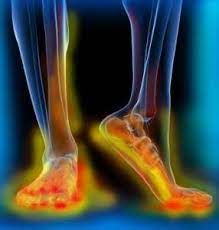New Treatments for Painful Diabetic Neuropathy

What is a Neuropathy?
We have billions of nerve fibers throughout our bodies. They are everywhere including the skin, heart, stomach, and anywhere else you can imagine. These small nerve fibers control everything from our ability to digest food, to the ability of the pupil to constrict when exposed to sunlight, to the beating of our hearts. In the skin, these nerve fibers are plentiful, and we refer to them as peripheral nerves. They are responsible for our ability to sense temperature, pain, and light touch. Without peripheral nerves, you would be unable to feel or manipulate an object in your hands, you would be unable to feel the floor beneath your feet, and you would be unable to sense damage when your hand was touching a hot iron. The ability for these senses to work rely on nerves that are healthy and “firing” appropriately. The term “neuropathy” refers to damage to these peripheral nerves. Neuropathies can occur for many reasons including exposure to toxins (ie chemotherapy and heavy metals), metabolic abnormalities such as diabetes, virus exposure, nutritional deficiencies, and many more. Since the longest nerve fibers are most vulnerable to injury, the nerve damage most commonly occurs in the feet and travels up the legs before eventually spreading to the hands.
What is Painful Diabetic Neuropathy?
Many patients with diabetes suffer from painful diabetic neuropathy, also known as PDN. This condition occurs when the small nerve fibers are damaged as a result of elevated blood sugars in patients with diabetes or pre-diabetes. Nerve damage causes severe pain often described as burning, stabbing, and tingling. Typically, patients will first notice discomfort in their feet. Over time the nerve damage spreads up the leg to the knees, and it may eventually spread to the hands. The nerve damage caused by diabetes is usually irreversible, and therefore, the pain from PDN is lifelong. The main symptoms of painful diabetic neuropathy include the following:
- Tingling or prickling feeling
- Numbness
- Increased pain
- Loss of reflexes
- Stabbing or shooting pain that is most intense at night
- Vascular abnormalities or ulcers in the legs
- Muscle cramping
- Poor balance and difficulty walking
Diagnosis of Peripheral Neuropathy
There are many possible causes for peripheral neuropathy. Unfortunately, about fifty percent of neuropathies are labeled as “idiopathic,” which means that the cause is uncertain. The physical examination and patient history are the two most important components for diagnosing a neuropathy. The workup to determine the cause for neuropathy includes bloodwork and special neurological studies. The bloodwork is for the purpose of diagnosing an underlying cause. The bloodwork can be extensive. It includes evaluation for infections such as Lyme’s disease, autoimmune conditions such as Lupus, nutritional deficiencies such as vitamin B, metabolic abnormalities such as diabetes, and toxic exposure such as lead. The special neurological studies include electromyography and nerve conduction studies (EMG/NCS), which is an invasive treatment performed by a physician. The EMG/NCS is designed to determine which nerves are injured, the extent of the injury, the type of nerve damage (motor vs. sensory), and additional information. A normal EMG/NCS and normal bloodwork does not exclude the diagnosis of peripheral neuropathy.
Together, the physical examination, patient history, EMG/NCS, and bloodwork can aid in diagnosis and treatment.
Treatment of Painful Diabetic Neuropathy
Diabetes is the most common cause for neuropathy in the United States. At DVPSI, we evaluate each patient carefully to determine an appropriate individualized treatment plan. Many treatments exist, and they include:
- Painful neuropathies can be treated with medications such as gabapentin, pregabalin, and duloxetine. In rare cases, opioids may be helpful to reduce the pain associated with neuropathy.
- Nerve blocks may help to decrease the severe nature of the pain related to neuropathy. This may include blockade of the nerves in the feet or blockade of the sympathetic nerves.
- Alternative therapies such as TENS units and acupuncture may be helpful.
- Topical pain medications applied to the skin may be helpful (see below).
- More advanced pain management treatments include spinal cord stimulation, which was recently approved by the FDA for the treatment of painful diabetic neuropathy (see below).
New Treatments for Painful Diabetic Neuropathy
Breakthrough, cutting edge treatments for PDN were recently approved by the FDA. At DVPSI, we are at the forefront of these therapies, and our very own Todd Bromberg, M.D. was recently on the advisory panel that helped to gain FDA approval for spinal cord stimulation. The two breakthrough therapies include Spinal Cord Stimulation and Qutenza topical patces.
- Spinal Cord Stimulation (SCS)
- Spinal cord stimulation is a minimally invasive treatment whereby electrical signals are applied to the spinal cord through surgically implanted wires.
- When electrical signals from PDN reach the pain centers in the brain, patients with PDN experience pain. SCS works by interrupting pain signals that travel along the spinal cord. By preventing the signals from reaching the brain, patients cannot feel the pain.
- Prior to 2021, SCS was approved for two indications only: Failed Back Surgery Syndrome and Complex Regional Pain Syndrome. We are now excited to announce that the FDA has approved a third diagnosis, which is painful diabetic neuropathy. The approval for PDN was based on a clinical study showing that approximately 80% of patients with SCS reported greater than 50% pain relief. On the other hand, medical management alone provided 50% relief in only 5% of the patients.
- SCS is minimally invasive. In order to determine if you are an appropriate candidate, a “trial” is performed during which temporary wires are placed for five days. If the trial is successful, you would be a candidate for the more permanent implant. The trial is performed through an epidural needle, which may be performed in the office or surgery center setting.
- Qutenza Patch
- Qutenza is a patch placed on the skin. It contains capsaicin, which is the active ingredient in chili peppers. This patch is applied to the feet every three months in the physician’s office. Prior to the treatment, you receive topical lidocaine, which anesthetizes the nerves in the feet. Multiple Qutenza patches are applied to the feet, where most patients with PDN experience pain. Qutenza patches have minimal side effects. In rare cases, it may cause mild discomfort of the skin. Unlike most other medications used for PDN, it does not cause dizziness or sedation. Also, it does not interact with other medications.
- Qutenza patch works by desensitizing an important protein on the nerve fiber that leads to pain called the TRPV-1 receptor. Over time, continued use of Qutenza decreases the density of these nerve fibers in the skin.
- Since the nerve fibers regenerate, this treatment must be repeated every four months.


Recent Comments